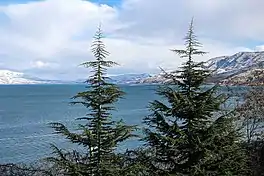| Lake Hazar | |
|---|---|
 Lake Hazar and pine trees | |
 Lake Hazar | |
| Location | Taurus Mountains |
| Coordinates | 38°29′N 39°25′E / 38.483°N 39.417°E |
| Lake type | Rift Lake |
| Primary outflows | Tigris |
| Basin countries | Turkey |
| Max. length | 22 km (14 mi) |
| Max. width | 6 km (3.7 mi) |
Lake Hazar (Turkish: Hazar Gölü; Armenian: Ծովք լիճ, romanized: Covk‘ lič) is a rift lake in the Taurus Mountains, 22 km southeast of Elazığ, notable as the source of the Tigris. It was formerly known as Lake Geoljuk.

During the Armenian genocide the lake was used as an execution site.[1][2]
Sunken city
Scientists found 4,000-year-old archaeological traces of a city below the lake. The city has been submerged in Lake Hazar, since 1830. Turkey wants to register its historic 'Sunken City' in eastern Anatolia as a UNESCO World Heritage Site.[3]
Ebubakar Irmak, Mayor of Sivrice, said he dove into the lake in 2017 and saw the remains of churches, walls of a castle, pots, pottery and glazed plates of the citadel with traces of the Seljuk, Byzantine and Ottoman era.[4][5] In 2019, amphora tombs were also found in the sunken city.[6]
References
- ↑ Kaiser, Hilmar (2010). "Genocide at the Twilight of the Ottoman Empire". In Bloxham, Donald; Moses, A. Dirk (eds.). The Oxford Handbook of Genocide Studies. Oxford University Press. ISBN 978-0-19-923211-6.
- ↑ Kinzer, Stephen (10 May 2000). "Turkish Region Recalls Massacre of Armenians". The New York Times. Retrieved 13 September 2021.
- ↑ "Ancient underwater city in Turkey sparks interest". Ancient underwater city in Turkey sparks interest (in Turkish). Retrieved 2018-08-23.
- ↑ "Underwater ancient city in Turkey sparks interest". Retrieved 2018-08-23.
- ↑ Şafak, Yeni. "Underwater ancient city in Turkey sparks interest". Yeni Şafak (in Turkish). Retrieved 2018-08-23.
- ↑ Amphora tombs found in sunken city